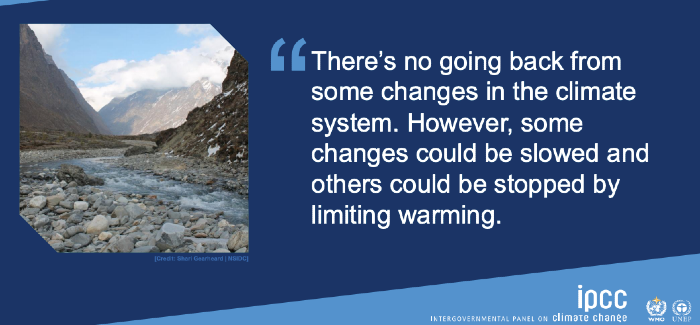
2021-08-13 17:42:01
Sustainable Beauty: The Beauty Industry’s Role in Mitigating Climate Change
2021-08-13 17:42:01
Earlier this week, leading scientists from the Intergovernmental Panel on Climate Change released a landmark report warning that global climate change is accelerating—and human-caused emissions of greenhouse gases are the overwhelming cause.
Heatwaves, extreme rain and intense drought are on the rise, but the extent of future disasters will be determined by how fast governments can adapt and evolve, the report argues.
“From a physical science perspective, limiting human-induced global warming to a specific level requires limiting cumulative CO2 emissions, reaching at least net zero CO2 emissions, along with strong reductions in other greenhouse gas emissions. Strong, rapid and sustained reductions in CH4 emissions would also limit the warming effect resulting from declining aerosol pollution and would improve air quality,” the report reads.
Beauty Brands That Have Taken Action
While the diagnosis may seem dire, scientists say there is still time to prevent catastrophic climate change. Many global beauty companies have already taken steps to reduce emissions and halt the use of fossil fuels, including the following examples:
Estée Lauder
Last year, The Estée Lauder Companies (ELC) announced that it had achieved Net Zero emissions and sourced 100% renewable electricity globally for its direct operations.Building upon this achievement, the company also met its goal to set science-based emissions reduction targets for its direct operations and value chain, positioning the company to take even more decisive action against climate change in the coming decade.
“Setting ambitious targets in line with the latest climate science is testament to our values and commitment to managing our business for the long term,” said Fabrizio Freda, president and CEO of ELC. “In this decisive decade for climate action, we will continue to accelerate efforts to ensure a healthy, beautiful planet for generations to come.”
Arbonne
Arbonne is another company that understands that reducing energy demand and moving to renewable energy is crucial to doing its part to reduce greenhouse gas emissions driving climate change. By 2025, Arbonne expects to:- Divert over 90% of its waste, globally
- Reduce water consumption by 20% compared to a 2019 baseline
- Reduce greenhouse gas emissions by 50% compared to 2019, and then 75% by 2030
- Reduce energy consumption by 20% compared to 2019
L’Oréal
L’Oréal has also set bold, measurable targets for 2030 on climate, water, biodiversity and natural resources, in accordance with what scientific experts demand and what our planet needs.Since 2005, the Group has reduced the CO2 emissions of its plants and distribution centers by 81% in absolute terms, exceeding its initial target of 60% by 2020, while production volume increased by 29% over the same period.
Furthermore, at the end of 2020, L’Oréal had 72 carbon neutral sites (meaning they use 100% renewable energy), including 19 factories.
These companies and many more are making progress to reduce the impact and severity of climate change. They have set ambitious goals for themselves and acted on them, but it will likely take an effort from the whole industry to limit global warming.

“The cosmetics industry produces more than 120 billion units of packaging annually—the problem is larger than any individual brand, vendor or corporation,” explains Jess Abrams, executive director, sustainable development, Shiseido Americas. “It’s all about industry alignment. This is where I see the future of sustainable beauty heading—becoming an industry that brings together vendors, suppliers, and competitors alike.”
(Read The Future of Sustainable Packaging: Insights from Beauty Brands & Packaging Designers)
This process of rallying the industry together for a common goal will be challenging, and is certainly easier said than done, but the good news is that according to the results of a representative population survey commissioned by the German Packaging Institute (Deutsches Verpackungsinstitut), the multitude of innovations in the field of sustainable packaging in recent years are being well received by consumers.
Nearly half of respondents – 44% – perceived clear progress in environmental friendliness of packaging, and only 15.7% saw it as having regressed. Moreover, three out of four respondents, 74.6%, confirmed that this progress has been achieved either with no compromise in functionality and convenience – or even enhancing it.
Business as Usual Won’t Cut It
The IPCC report emphasizes that many changes due to past and future greenhouse gas emissions are irreversible for centuries to millennia, especially changes in the ocean, ice sheets and global sea level. That means that the time for actions is now. There is hope for the future, as exemplified by the companies that are already making a difference, but it is debatable whether the global Beauty Industry as a whole has done enough to reduce its impact on our planet.
Swedish climate activist Greta Thurnberg had this to say during a recent interview for Democracy Now: “This report doesn’t tell us what to do. It doesn’t say you have to do this, and then you have to do this. It doesn’t provide us with such solutions or tell us that you need to do this. That’s up for us. We are the ones who need to take the decisions, and we are the ones who need to be brave and ask the difficult questions to ourselves, like: What do we value? Are we ready to take action to ensure future and present living conditions?”
The facts about climate change and global warming are available and clear. The question is whether the Beauty Industry can be the positive influence that it has the potential to be.
LinkedIn




